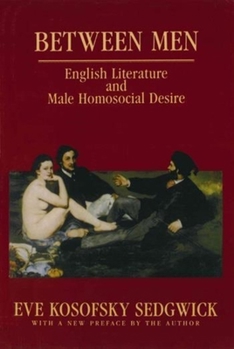Between Men: English Literature and Male Homosocial Desire
(Part of the Gender and Culture Series Series)
Select Format
Select Condition 
Book Overview
Hailed by the New York Times as "one of the most influential texts in gender studies, men's studies and gay studies," this book uncovers the homosocial desire between men, from Restoration comedies to Tennyson's Princess.
Format:Paperback
Language:English
ISBN:0231082738
ISBN13:9780231082730
Release Date:April 1985
Publisher:Columbia University Press
Length:244 Pages
Weight:0.85 lbs.
Dimensions:0.7" x 6.0" x 9.0"
Grade Range:Postsecondary and higher
Related Subjects
Criticism & Theory English Literature European Gay & Lesbian Gay & Lesbian Studies History History & Criticism Literary Criticism Literary Criticism & Collections Literary Theory Literature Literature & Fiction Movements & Periods Nonfiction Politics & Social Sciences Self-Help Sex Social Science Social Sciences Specific Demographics World LiteratureCustomer Reviews
2 ratings
brilliant beginning but better stuff to follow
Published by Thriftbooks.com User , 18 years ago
At the time of its first appearance in 1985 Between Men was viewed as an important intervention into Feminist as well as Gay and Lesbian studies. It was an important book because it argued that "sexuality" and "desire" were not ahistorical phenomenon but carefully managed social constructs. This insight (that actually originated with Michael Foucault) is often viewed as anti-humanist or post-humanist because it argues that men and women are simply the products of patriarchal power relations over which they have no control. By mobilizing Foucault's theories of the history of sexuality Sedgwick re-fashions Feminism and Gay and Lesbian Studies to make it seem as though Feminism and Gay and Lesbian studies are ideally situated to continue those interventions into the history of sexuality begun by Foucault. Sedgwick's own concern in this book is homosocality and this book's contribution to that topic is invaluable and still provides an excellent starting point for any foray into that topic. Her views on homosociality were groundbreaking, however, Sedgwick's book is famous mainly for its introduction which critiques current research agendas (including radical feminist agendas)as well as spells out the research agendas that she feels Gay and Lesbian studies should pursue. Its a twenty page introduction that to this day remains the best synopsis of academic feminisms (especially radical feminism) as well as the best articulation to date of the need for a new kind of discipline that can make use of the best part of existing feminisms and continue to evolve Gay and Lesbian Studies in productive directions. In that twenty page introduction Sedgwick lays out an academic template that has retroactively been labeled Queer Studies. For that introduction this book deserves five stars. The rest of the book is dedicated to new readings of classic Eng Lit texts and will only be of interest and of use to students of English literature. Overall the book is appealing because Sedgwick draws a map that is in fact usable. The pitfall of this book is that she uses this map to explain everything. This is of course a charge that can be made against any theorist that believes that their new theory holds the secret to history, to desire, to sexuality, to subjectivity, to relationships of all kinds, to every social situation and to every literary work. Its only later that we begin to see that any theory also has blind spots. Like Foucault Sedgwick treats "masculinity" and "femininity" and "lesbian" and "homosexual" not as natural and stable categories but as historically contingent and shifting categories. This is fine so far as it goes but it also means that in order to challenge these categories and effect structural changes to the way we view gender and sexuality the academic must argue from some privileged position that allows them access to the ways society shapes its subjects and also allows some privileged insight into how historical change occurs. Again this i
Important, compelling, enduring.
Published by Thriftbooks.com User , 25 years ago
Sedgwick brilliantly transformed gay and lesbian studies with this book, a text whose import has not diminished with the transition of gay and lesbian studies from the margins of academia to (at least closer to) the mainstream. While she uses as her framework here English literature, this framework does not bound her theories conceptually. Look, for example, at ch. 1, "Gender Asymmetry and Erotic Triangles". Consider the triangulation of rapist, victim and spectator in representations of rape, such as in Kaplan's film "The Accused" - while she does not explicitly deal with contemporary media and textuality, it can certainly be applied. Certainly, the text could now be updated - there are literally thousands of contemporary examples which could apply, and which could, perhaps make for more accessible reading. However, such a rewriting would not substantially change Sedgwick's ideas, and the challenge of reading and absorbing SEdgwick is something which I have come to enjoy time and time again.





